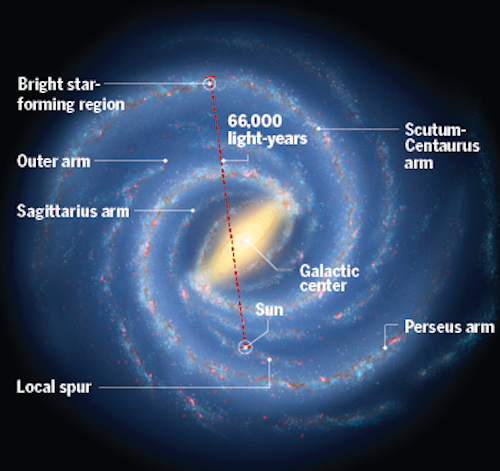Astronomers map Milky Way’s most distant outpost

A galactic portrait
Astronomers have mapped a star-forming region through the haze of the galactic center and firmed up views that the Milky Way has four main arms.
-
In the mid–19th century, William Parsons, an astronomer and Ireland’s 3rd Earl of Rosse, built himself what was then the largest telescope in the world, the 1.8-meter “Leviathan of Parsonstown.” With it, he discerned the spiral forms of nebulae, curled like nautilus shells—objects only later understood to be distant galaxies. In 1852, Stephen Alexander, an astronomer at Princeton University, took to the pages of The Astronomical Journal with a bold theory: Maybe, he argued, the Milky Way, a bright ribbon splashed across the sky, was another such spiral nebula—but seen from the inside.
He was right. Yet even now, the work of understanding the structure of the Milky Way is unfinished. It is difficult to map from the vantage of the solar system, which sits in the disk of the galaxy, on a spur of one of its spiral arms. Clouds of gas and dust obscure the view, especially along sightlines through the galactic center.
Now, astronomers are mapping the arms with the help of star-forming regions that contain clouds of water vapor, glowing brightly with radio waves that can penetrate the gas and dust. By measuring them, the observers have traced points throughout the arms, like lighthouses on a coastline. Among them is the most distant outpost ever mapped, a result described this week in a study in Science.
“This is something amazing,” says astronomer Alberto Sanna of the Max Planck Institute for Radio Astronomy in Bonn, Germany, who led the study. “Essentially we are looking at the other side of the galaxy.”
Debra Elmegreen, an astronomer at Vassar College in Poughkeepsie, New York, says the results are a major advance in piecing together a bird’s-eye view of the Milky Way. “I was really excited to see this paper, when they finally had an arm going from an inner region to an outer part,” she says.
Astronomers produced the first maps of the Milky Way in the 1950s, by tracking bright clouds of hydrogen gas. Their motions made it possible to infer how far these clouds were from the galactic center and, in turn, plot the rough location of the denser spiral arms. But those maps were error-prone. The new study is the latest from the Bar and Spiral Structure Legacy (BeSSeL) Survey, an international group that maps the location of points in the galaxy directly.
From 2010 to 2015, the team spent about 3500 hours tracking the water vapor signals with the Very Long Baseline Array, a set of 10 25-meter radio dishes, scattered around the United States and its territories, that create a virtual telescope powerful enough, in theory, to tell apart two pennies placed side by side on the moon. By taking measurements 6 months apart, when Earth is on opposite sides of the sun, the team could look for apparent shifts in the position of the water clouds against more distant galaxies. From this parallax effect, it took no more than basic geometry to calculate the clouds’ positions. “We put a little X on the map,” says Mark Reid, BeSSeL’s leader and an astronomer at the Harvard- Smithsonian Center for Astrophysics in Cambridge, Massachusetts. “If we do this for hundreds of them, we see that they trace out spirals.”
Almost all of the roughly 150 clouds mapped so far turned out to be just a few thousand light-years away, tracing out arms on this side of the galactic center. So it was a shock when the team found a beacon 66,000 light-years away—on the opposite side of the galaxy, farther from its center than the sun is. “It was kind of funny, this discovery,” Sanna says.
The cloud’s position, cross-referenced with its motion, indicates that it belongs to the outer reaches of the Scutum-Centaurus arm, which sprouts on this side of the galaxy and wraps around to the far side. Meanwhile, the closer beacons mapped earlier support an emerging consensus that, in addition to Scutum-Centaurus, the galaxy has three other arms, which Reid’s team calls Sagittarius, Perseus, and Outer. The sun belongs to the small Local spur, sandwiched between the Sagittarius and Perseus arms.
Other teams are joining the mapping effort. A Japanese group is relying on the same basic strategy as BeSSeL, and a Brazilian group is using archival satellite data to map clusters of newborn stars glowing in infrared light, which also passes through dust. For their part, the BeSSeL team starting next year plans to use an Australian radio array to see parts of the Milky Way visible only in the Southern Hemisphere.
One new competitor looms over the entire field. In April 2018, the European Space Agency’s Gaia probe will release 3D coordinates for more than 1 billion Milky Way objects, most of them stars, which should show the spiral arms, especially the nearby ones, in unprecedented detail. “A lot of this work is being done by people racing to get their results out before the Gaia results come out,” says astronomer Gerry Gilmore of the University of Cambridge in the United Kingdom, who leads the U.K. Gaia team.
Gaia won’t unveil all of the Milky Way, though. “They often forget that they can’t see through dust,” Reid says. Gaia works in optical wavelengths, which cannot penetrate the haze of the galactic center to reach the obscure regions that BeSSeL is now probing.
A good map of the Milky Way would aid other astrophysical quests. For example, knowing the true location of a particular binary pulsar—a pair of spinning neutron stars—would improve a Nobel Prize-winning test of Albert Einstein’s theory of general relativity that relied on the pulsar signals. But Reid has a simpler goal. “My primary motivation is just to see what the Milky Way looks like,” he says. “It just seems like such a cool thing to do.”
Quelle: AAAS
